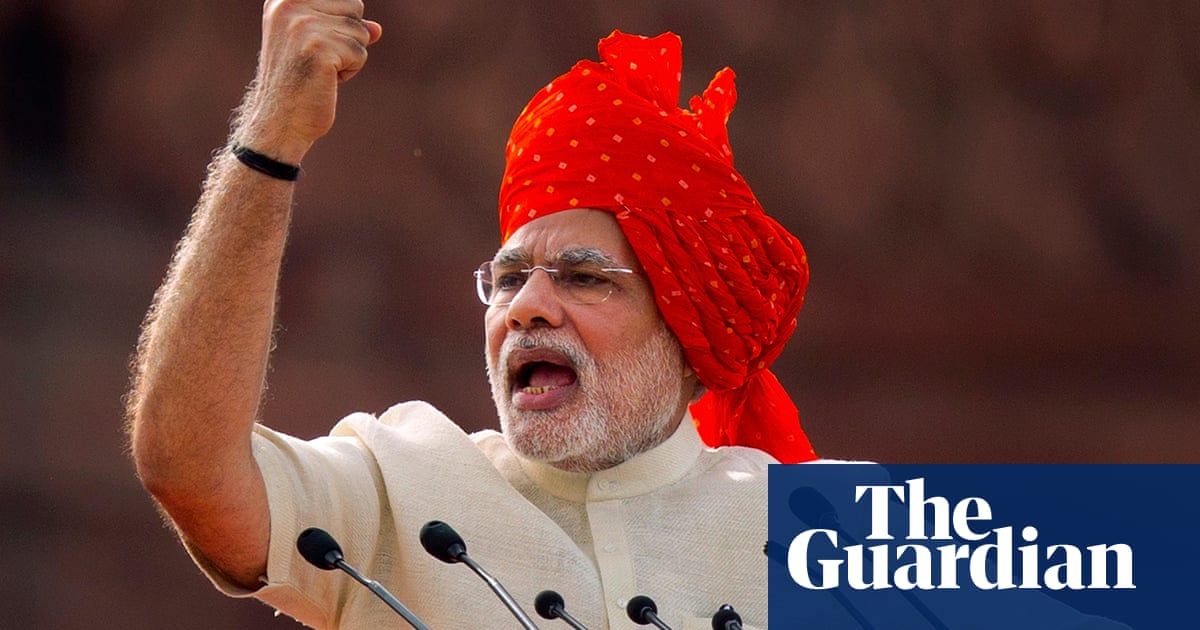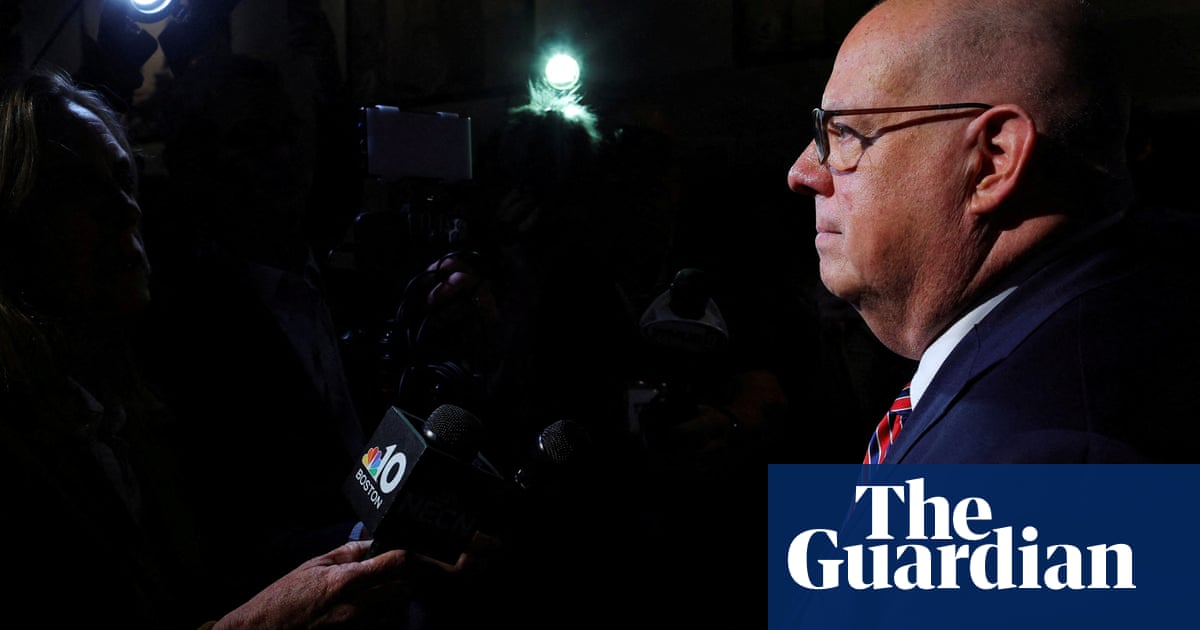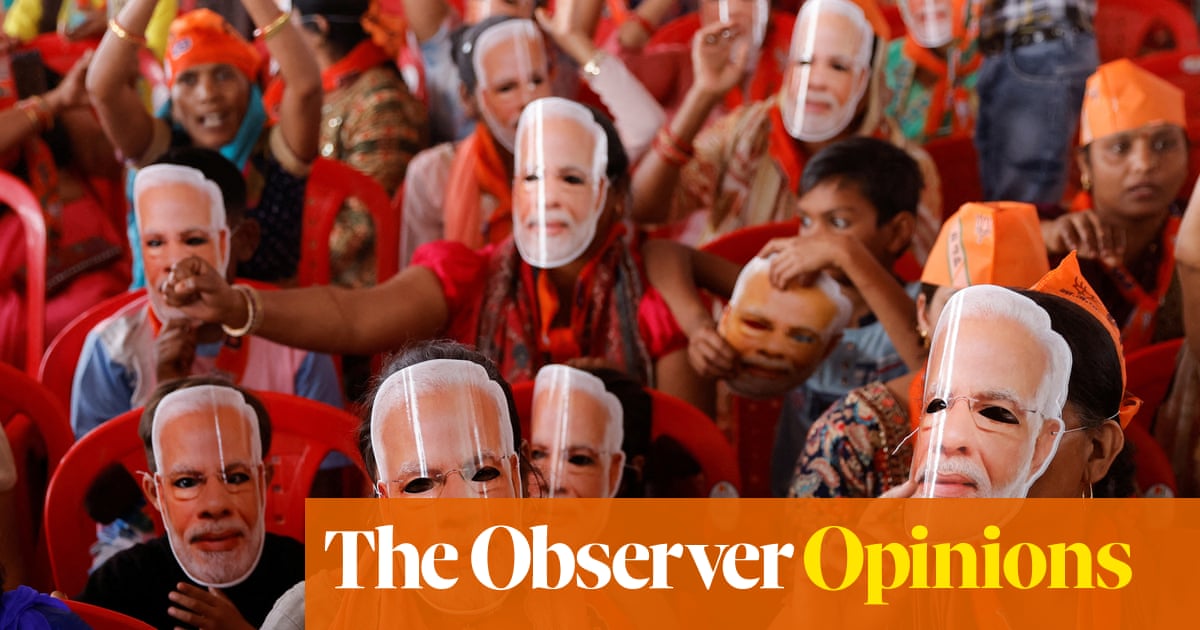
As the distant rumble of a helicopter drew closer, cheers erupted from the gathered crowds in anticipation. By the time India’s prime minister finally stepped on to the stage, bowing deeply while immaculately dressed in a white kurta and peach waistcoat and with a neatly trimmed beard, the chants had reached a deafening pitch: “Modi, Modi, Modi.”
These scenes, at a campaign rally on the outskirts of the Uttar Pradesh city of Meerut, have been replicated across the country in recent weeks as Modi and his Bharatiya Janata party (BJP) seek to win a third term in India’s election, which begins on 19 April and goes on for six weeks.
Pundits and polls have resoundingly predicted that Modi will be brought back to power when election results are counted on 4 June.
Whether the BJP will be able to win the same strong majority as in 2019 remains uncertain. But in Meerut, the reverential status many in India have attached to their prime minister was vividly on display. Some called for him to rule India for the next 50 years, others spoke of him as an almost holy figure. Many wore masks of his face.
“He casts a certain messianic spell on his voters,” said Dwaipayan Bhattacharyya, a professor of political science at Jawaharlal Nehru University in Delhi. “It’s this combination of political power and perceived divinity in his persona which enables the BJP to project him as the one beyond scrutiny.”
There is little doubt among Indians that Modi’s 10 years in power have already left an indelible mark on the country. To some it is the optimistic story of India rising to become the world’s fastest-growing economy, courted by powerful western leaders and multinational corporations; of efficient governance and technological advancements that have benefitted the public; and of the country freeing itself from the politics of elites and the “chains of colonisers” while reclaiming its historic Hindu civilisational greatness.
Yet to others it is a story of democratic backsliding and growing authoritarianism; of crony capitalism and a growing chasm between rich and poor; of the erosion of freedom of the media and judicial independence; attacks on secularism, liberal institutions and civil society; of publicly condoned Islamophobia and growing state-sponsored persecution of minorities, primarily India’s 200 million Muslims.
Modi’s status – what many refer to as a “cult of personality” – has continued to rise exponentially while space for criticism of him, be it in the media, academic research or even fictional TV shows, has continued to be in sharp decline. Notably, he has not done a single press conference in 10 years. “Opposition to Modi is painted as opposition to the country itself,” said Bhattacharyya.
Such is the power of “brand Modi” that the BJP sits firmly in the shadow of its strongman leader. Modi’s face and name are attached to almost every government welfare scheme, and are visible on every government poster and even on people’s food rations and Covid vaccination certificates. The prime minister primarily refers to himself in the third person in speeches and will often address the people as “Modi ka parivar” [Modi’s family]. The party’s election manifesto was simply named “Modi’s guarantee”.
“Modi is very full of himself,” said one BJP figure who requested anonymity due to the repercussions of discussing the prime minister to the media. They described him as prone to answering questions with “long, self-important stories”.
“But Modi’s ego is what gives him the ability to have this grand vision for what India will become,” they added. “He is talking about laying the groundwork for the country for the next 1,000 years.”
Narendra Damodardas Modi was born in 1950 in a small town in northern Gujarat, as the third of six children, to a poor, lower caste family. Growing up, their house did not have electricity and his father produced cooking oil and ran a small tea shop next to the local railway station.
His modest upbringing as the son of a chaiwallah, who would help out at his father’s stall as a child, has become a hallowed part of Modi’s populist narrative, helping to project him as incorruptible – opposite to the elite, dynastic families that have dominated Indian politics for decades – as well as giving him appeal among poorer, lower caste communities that previously never voted BJP.
According to Modi’s biographer Nilanjan Mukhopadhyay, even as a child Modi displayed traits that would later define his political career. Recalling a conversation with one of Modi’s teachers from his time at school, Mukhopadhyay said: “Modi liked theatre a lot in school, but would only do leading roles. If he did not have the main role, he would not perform in that play. It’s a small glimpse into how he has always put himself at the centre of his own universe.”
It was as an eight-year-old child that Modi first wandered into the offices of the Rashtriya Swayamsevak Sangh (RSS), the rightwing Hindu paramilitary organisation that has worked for almost a century to push India towards becoming a Hindu state. His interest in the RSS began as a form of extracurricular entertainment in his otherwise quiet village but he soon began to take a proactive role as a volunteer, participating in activities and local outreach programmes to promote Hindu identity.
To this day, over six decades on, RSS ideology remains the foundation of Modi’s political beliefs and his agenda as prime minister. Under his two terms, militant Hindu nationalism has become the dominant political ideology in India, while core RSS policies have been brought to fruition and RSS figures are present in almost all main institutions.
After finishing school, Modi decided to dedicate himself fully as an RSS footsoldier, known as a pracharak, which meant he had to be subservient to the organisation, including a commitment to remain celibate and not to marry.
Yet he had a secret he would keep for years: aged 13, his parents had arranged his marriage to a local girl. After Modi left home at 17, he reportedly never moved in with his wife and did not disclose her existence. One Indian journalist who later tracked her down when Modi became the chief minister of Gujarat found her living in poverty, with no contact or support from him.
In 1987 the RSS deputed Modi – who had earned a reputation as a dynamic, efficient organiser – to be part of the newly formed BJP, a party born out of the organisation’s desire to forward its agenda through politics. By 2001, Modi’s stature and ambition had grown to such an extent that when BJP won the Gujarat state elections, he was named chief minister, the first RSS pracharak to hold such high political office.
Almost immediately after he became chief minister, events unfolded in Gujarat that would colour his reputation for ever. In February 2002, train coaches carrying Hindu pilgrims were set alight after a dispute, killing 59 people. Muslims were blamed and the following day a coordinated attack by rightwing Hindu groups began on Muslim neighbourhoods, where hundreds were tortured, killed, burned alive and gang raped, while the police were accused of standing by. More than 1,000 people were killed, about 800 of them Muslims.
Modi was accused of inflaming the violence, known as the Gujarat riots, and of not giving police orders to halt the anti-Muslim pogroms. He has never apologised for the riots and his alleged complicity led to him being banned from the US for nearly a decade.
Yet, rather than ending his political career, Modi went on to remain chief minister for the next 12 years. Much of what he implemented in Gujarat, in particular an emphasis on infrastructure and a close relationship to a select few big businessmen – leading to early accusations of “crony capitalism” – was then replicated on a national scale after he was elected prime minister in 2014.
According to Christophe Jaffrelot, a professor of Indian politics and sociology at King’s College London who has authored two books on Modi, the “building of a deliberate, carefully curated cult of personality” around Modi also began in Gujarat, but rose to new heights once he became prime minister and began an unprecedented concentration of power under himself.
“From the beginning, Modi always used fear as a tool, terrorising and intimidating those who opposed him,” said Jaffrelot. “Capturing and using the media has also been vital in creating this Modi cult. Just look at how he has crushed all independent and critical media over the past 10 years. It’s much easier to appear as all-powerful when that’s how the media presents you.”
Even those in the BJP conceded that the party was now largely the Modi show. “There’s no doubt that he has single-handedly led from the front and that has helped to build up this cult status, this aura around him,” said Swapan Dasgupta, a member of the BJP executive and former parliamentarian for the party.
Dasgupta credited Modi for implementing a “transformation” over the past 10 years. “He has brought about significant assertion of self-confidence in India, a celebration of Indianness if you will,” said Dasgupta. “Also in the past, there was always a squeamishness attached to the idea of asserting yourself to be Hindu. That squeamishness has now been replaced by pride.”
Many of Modi’s traits – from his performative style of public speaking to his love of sharp dressing – have remained consistent, if constantly finessed, over his decades in politics. However, analysts said there were growing efforts by Modi to present himself not only as a political leader but also a religious one. At events such as the consecration of the Ram Temple in the holy town of Ayodhya in January, which had long been a core RSS objective, Modi took a central role, projecting himself as the “high priest of Hinduism”, as Mukhopadhyay described it.
“Ultimately, he is driven by securing himself permanence in Indian history,” added Mukhopadhyay. “Modi wants to go down as the most popular, most important leader of modern India – bigger even than Gandhi.”












